Luxury Hospitality in 2017: Simplicity, Wellness and Integrated Experiences

Skift Take
Luxury hospitality groups and tour operators are saying that their guests today are craving more simplicity, better wellness options, and a greater convergence of experiences combined together in one place.
The luxury consumer in 2017 is seeking integrated experiences that align their various passions in a seamless whole, whereby the convergence of elements delivers a sum greater than its parts.
According to The Future Laboratory's new Luxury Futures Report 2016, "Luxury brands are becoming convergence spaces that facilitate culture, education and wellness, combining diverse consumer needs into a single, multifaceted lifestyle zone."
In travel today, the most forward-thinking luxury hotels are playing the role of those convergence spaces.
During the International Luxury Travel Market (ILTM) conference in Cannes last month, many hospitality executives emphasized that their guests want the best in food, wellness, culture, and activities combined together in one destination, with the hotel acting as the curator to customize the experience. Luxury guests especially want access to everything that wealthy locals have access to, and they want it provided within a context that educates them as much as possible about the local community and culture.
According to Tim Davis, VP, brand & marketing at Small Luxury Hotels (SLH), there's a rise in demand for smaller hotels under 30 rooms because, he argues, they tend to provide a more easily navigable, stress-free, relaxed, and locally immersive travel experience.
That's driving the company's membership development strategy. SLH added 57 new properties to its portfolio in 2016 with an overall average size of 28 rooms. That contrasts significantly in comparison to the company-wide average of 48 rooms across the consortia's 510 hotels and resorts previous to 2016.
"Small has never been bigger," said Davis. "Our guests' passion for immersive authentic experiences is not new but it's more important for them than ever before. They want to feel that they are really staying where they are staying."
SLH has identified four primary trends for 2017 which it labels: Love of Local, Experiences of a Lifetime, Digital Detox, and Sophisticated Simplicity. With regard to the latter two relating to reducing stress in-destination, Davis said, "Luxury travel today is about getting away from social media and throwing your phone in the pool. It's about getting bac
